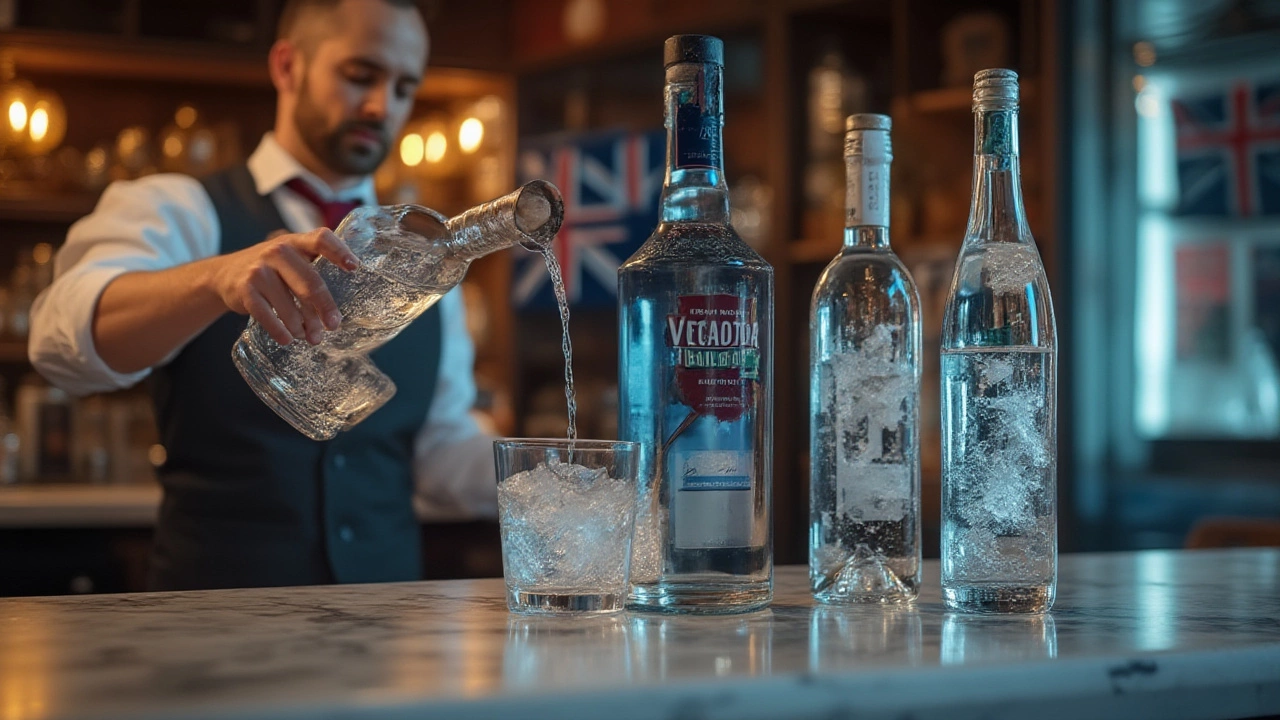Wet cement. That’s what a lot of people picture when they think about drinking vodka straight. But here’s a little secret: with the right bottle, you get something closer to silk than construction dust. At its best, vodka slips past your lips with a milky smoothness and creamy finish—none of that throat-burn you remember from college. Some brands take this to a whole new level, aiming for world records in smoothness. The texture, aroma, and subtle sweetness all work together, letting the “ru” in vodka shine (it literally means “little water” in Russian). For sippers, the search for the smoothest vodka isn’t just a drinking quest. It’s about finding that magic bottle you’re proud to pour neat, no chasers, no mixers.
What Makes a Vodka Smooth?
Smoothness isn’t only some marketing buzzword. It comes down to how the vodka is made—from the grain or potato it comes from, to how many times it’s distilled and filtered. Let’s start with the basics. Vodka typically arrives in your glass with very few natural flavors: that’s intentional. The smoother the vodka, the fewer harsh notes you detect. Many distilleries use winter wheat, rye, corn, potatoes, or even grapes. Each one can bring tiny nuances to the texture and aftertaste. Premium brands love wheat and rye for their natural smoothness, while potato vodkas claim creamier, thicker bodies.
Distillation and filtration are where the smoothness magic happens. The more a vodka is distilled and refined—the more impurities are stripped away—the clearer and softer it tastes. Some bottles brag about being distilled five, six, or even eight times. But there’s a catch: over-distilling can also remove some character, leaving you with a bland sip. The trick is balance. Many connoisseurs like single-origin grain and moderate distillation—enough to get rid of rough edges, but not so much the vodka loses personality.
Then there’s filtering. Some vodkas go through quartz, diamond dust, charcoal, or even precious metals like platinum. Each option filters out tiny elements that can add bitterness or harshness, so what’s left is pure and silky. Iceland’s Reyka, for example, filters through lava rocks, claiming it gives the vodka its soft touch. But it isn’t just about fancy filtration systems. Water quality matters too. A lot. Grey Goose, for one, uses spring water from Gensac in France, and it’s ultra-soft (the brand even claims the local mineral content is what gives Grey Goose its signature finish). Tiny tweaks in water make massive taste differences.
Here’s a wild fact: The “mouthfeel” of vodka—how it glides or stings on your tongue—often depends on trace minerals from the source water. Some distilleries protect their water sources like secret family recipes, believing it’s the final ingredient in achieving true smoothness. And while many think vodka should be completely tasteless, actual experts argue that top-shelf bottles have gentle sweetness or a whisper of wheat, rye, or potato, adding to their smooth reputation.
Temperature plays a surprising role too, especially when sipping vodka straight. Chilling it dulls harsh notes and makes the body feel even silkier. Try storing the bottle in the freezer and pouring into a cold glass—the difference is night and day, almost creamy.
The Smoothest Vodkas to Drink Straight: Top Picks
It’s time to drop some names. Not all vodkas deliver that legendary silk finish, so let’s call out the ones that do, based on expert tastings and awards. You won’t find many of these in cheap plastic bottles on a bottom shelf. Here are the brands that get continuous praise for smooth sipping—just the way vodka should be enjoyed:
- Belvedere – Produced in Poland from locally sourced rye and quadruple-distilled. It has a clean aroma, soft vanilla finish, and a creamy mid-palate. No sugar or additives, just smooth complexity.
- Chopin – Also from Poland, but made with 100% potatoes. This vodka is known for its rich, velvety body and subtle earthy notes. Kind of an eye-opener if you’ve only tried grain spirits.
- Grey Goose – French wheat, limestone-filtered water, and a smooth, crisp, slightly sweet finish. Despite its luxury reputation, it lives up to the hype if you like a gentle, non-burning sip.
- Tito’s Handmade Vodka – American corn vodka picked for its pleasant mouthfeel and faint sweetness. It’s less refined than European brands, but its single-batch method offers surprising smoothness at a good price.
- Ketel One – Dutch wheat and charcoal filtration give this vodka a balanced, subtle spice and silky finish. Bartenders love it for a reason; it vanishes into the background when sipped cold.
- Crystal Head – Canadian corn vodka, filtered through Herkimer diamonds (yes, really). The result is a sweet, creamy, super-pure vodka with no detectable burn.
- Reyka – Icelandic vodka made from local barley and glacial water, filtered through volcanic rock. This one stands out for a lively, super-clean mouthfeel and nearly zero bite.
- Cîroc – Not your average vodka; it’s distilled from French grapes, which gives it an almost fruity softness you won’t find in traditional grain spirits.
Some experts also swear by Russian Standard Platinum and Zyr for their precision and water quality, though political tensions have made some Russian brands harder to find in the US and UK markets since 2022.
If you want to get technical—or just sound impressive at your next dinner party—here’s a quick breakdown of these vodkas’ claimed distillation/filtering steps and awards:
| Brand | Main Ingredient | Distillation Times | Filtering Method | Awards/Recognition |
|---|---|---|---|---|
| Belvedere | Rye | 4 | Charcoal | World's Best Vodka (IWSC) |
| Chopin | Potato | 4 | Cellulose Plates | Double Gold (San Francisco) |
| Grey Goose | Wheat | 5 | Limestone | Gold Medal (Beverage Testing Inst.) |
| Tito's Handmade | Corn | Pot Still, 6 times | Activated Carbon | Double Gold (San Francisco) |
| Ketel One | Wheat | Column & Pot, 3x | Charcoal | 98 points (Beverage Testing Inst.) |
| Crystal Head | Corn | 4 | Herkimer Diamond | Gold (International Spirits Challenge) |
| Reyka | Barley/Wheat | Small Batch | Lava Rock | Gold Medal (San Francisco) |
| Cîroc | Grapes | 5 | Charcoal | Double Gold (San Francisco) |
Don’t worry if your favorite didn’t make this list—taste is massively personal. Some people crave that whisper of pepper or bite. But if you’re chasing pure smoothness, you’ll see these names over and over among bartenders and expert panels.

How to Taste Vodka Straight Like an Expert
Pouring vodka neat isn’t like doing a shot. The smoothest options deserve a little attention. So how do you really get the most from sipping straight vodka? Here’s how to do it like you mean it:
- Use the right glass: Tall shot glasses or small tulip-shaped tasting glasses work best. They focus the tiny aromas hitting your nose before you sip.
- Chill, but don’t freeze (unless you like it icy): Slightly below fridge temp (around 0 to 4°C, or 32 to 39°F) is the sweet spot. Too cold, and you’ll miss out on the delicate texture.
- Check the aroma: Good vodka often has a clean, faintly sweet or bready smell. Stick your nose in, breathe in slow. Harsh vodka smacks you with a chemical tang—avoid those if you want smoothness.
- Sip slowly: Take a tiny sip and let it coat your tongue. A smooth vodka has almost no burn going down. Instead, you’ll feel a soft wash and a gentle warming in your chest, not your throat.
- Pay attention to aftertaste: Does the flavor vanish, or does it leave an oily, pleasant feel behind? The best vodkas leave your mouth feeling fresh, not stripped or dry.
For bonus points, try pairing your vodka with simple snacks: a slice of chilled cucumber, a bit of cold-smoked salmon, or even classic pickles. They clean the palate and highlight different notes in the vodka, affecting smoothness in fun ways. Russians and Poles have been doing it for centuries for a reason.
Vodka quality can even shift depending on the glass material and how fast you sip. Crystal glasses can give your vodka a silkier mouthfeel—hard to explain, but totally worth it. And on the science front, one real test for smoothness is the “legs” vodka leaves in the glass. A heavier, smoother vodka will leave slow, thick streaks—called tears—on the sides of the glass. Light, watery vodka beads up and runs straight down, usually hinting at a sharper burn.
If you taste a couple of the brands mentioned side by side, you’ll be amazed how different “neutral” can taste. One might give you an almost creamy, sweet feeling (like Chopin or Crystal Head), while another drifts into grainy or even lightly citrusy territory (like Ketel One).
And don’t be suckered by the bottle design alone. Distilleries know that fancy shapes and frosted glass sell. Crystal Head’s skull bottle is as Instagrammable as it gets, but the real test always comes in the glass.
Troubleshooting: Why Doesn’t My Vodka Taste Smooth?
So you dropped some cash on a premium bottle and it still feels like paint thinner? A few things could be going on. Not all “premium” vodkas are created equal. Sometimes, the brand is spending more on marketing than on actual distillation. Smirnoff and Absolut, for instance, are huge global sellers, but most connoisseurs don’t put them in the smoothest tier—they’re just reliable, consistent, and easy to find.
Storage matters, too. If your bottle’s been sitting open for months, it might start to lose freshness. Vodka doesn’t spoil quickly thanks to its high alcohol content, but it can go a little flat if uncapped for too long. Always keep it capped tight, preferably in a cool, dark place.
Did you forget to chill your glass or bottle? Warm vodka feels rougher and can amplify harsh notes. Stick your bottle in the freezer for a couple hours before sipping—even if the label says “best at room temp.”
Watered-down vodka is another sneaky culprit. Some bars (less reputable ones, let’s be honest) might top up bottles with tap water after hours. If your suspiciously cheap bar pour seems nasty, this could be why. Buy sealed bottles and pour your own for the smoothest experience.
Here’s a side note most blogs don’t mention: your palate actually changes depending on what you’ve eaten, drunk, or even how hydrated you are. Try sipping a neat vodka after spicy food and it’ll taste noticeably rougher. A quick snack, or even a sip of water, resets your tastebuds and makes a big difference.
Aging can also play a role. While vodka isn’t meant to be aged like whiskey, a handful of producers experiment with “resting” vodka in steel or glass for several months to let flavors settle and soften—this is rare, but can add a smoother twist (Belvedere releases very limited “rested” vodka now and then, which sells out fast).
As a last tip: always trust your own taste. If a vodka is hyped as smooth but you still grimace on the first sip, it’s not the right bottle for you. Swap up the brand or the base ingredient—if wheat vodkas aren’t doing it for you, give potato or grape-based a shot. The smoothest vodka to drink straight isn’t always the most expensive or the trendiest; it’s the one that leaves you smiling after the glass is empty.


